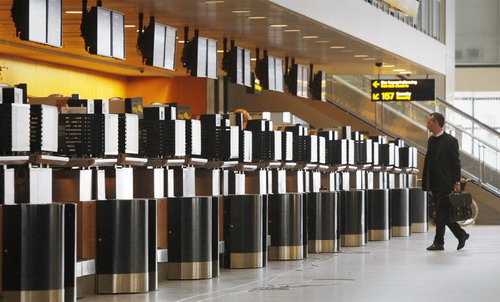Global General
Flight disruptions in Europe get even worse
(Agencies)
Updated: 2010-04-17 05:41
 |
Large Medium Small |
German Chancellor Angela Merkel had to go to Portugal rather than Berlin as she flew home from a US visit. Norwegian Prime Minister Jens Stoltenberg managed to get a flight to Madrid from New York but was still not sure when or how he would get back home.
The military also had to adjust. Five German soldiers wounded in Afghanistan were diverted to Turkey instead of Germany, while US medical evacuations for troops in Iraq and Afghanistan are being flown directly from the warfronts to Washington rather than to a care facility in Germany. The US military has also stopped using temporarily closed air bases in the UK and Germany.
Aviation experts said it was among the worst disruptions Europe has ever seen.
"We don't have many volcanoes in Europe," said David Learmount of Flight International, an aviation publication. "The wind was blowing in the wrong direction."
In Iceland, torrents of water carried away chunks of ice the size of small houses on Thursday as hot gases melted the glacier over the volcano. Sections of the country's main ring road were wiped out by the flash floods.
More floods from melting waters are expected as long as the volcano keeps erupting - and in 1821, the same volcano managed to erupt for more than a year.
Small amounts of ash settled in northern Scotland and Norway, but officials said it posed little threat to health.
The ash cloud, drifting between 20,000 to 30,000 feet (6,000 to 9,000 meters) high and invisible from the ground, initially blocked the main air flight path between the US east coast and Europe. On Friday, the cloud's trajectory was taking it over northern France and Austria and into eastern and central Russia at about 25 mph (40 kph).
Fearing that microscopic particles of highly abrasive ash could endanger passengers by causing aircraft engines to fail, authorities shut down air space over Britain, Ireland, France, Denmark, Norway, Sweden, Finland and Belgium. That halted flights at Europe's two busiest airports - Heathrow in London and Charles de Gaulle airport in Paris - as well as dozens of other airports, 25 in France alone.
Air space restrictions were lifted, imposed or extended Friday as the cloud moved.
Flights were suspended at Frankfurt airport, Europe's third-busiest terminal, and at other German airports including Duesseldorf, Berlin, Hamburg, Munich and Cologne.
Sweden and Norway declared skies in the far north to be safe but kept a lockdown on flights to both capitals - Stockholm and Oslo.
Aviation officials said the air over England would remain closed to flights until at least 1 pm (1200 GMT, 8 am EDT) Saturday, and British Airways announced it was canceling all of its flights to and from London airports late Friday and on Saturday. Airspace restrictions in Scotland and Northern Ireland have been lifted, and Irish aviation authorities reopened airports in Dublin and Cork.
In France, airports in Paris and about 20 other locations in northern France will remain closed until at least midday Saturday.
Belgium extended its flight restrictions until late Saturday morning.
Switzerland, Slovakia, Croatia and Hungary closed their airspace, and Poland expanded its no-fly zone to most of the country, excluding Krakow.
Iceland, a nation of 320,000 people, sits on a large volcanic hot spot in the Atlantic's mid-oceanic ridge and has a history of devastating eruptions. One of the worst was the 1783 eruption of the Laki volcano, which spewed a toxic cloud over Europe, killing tens of thousands.







